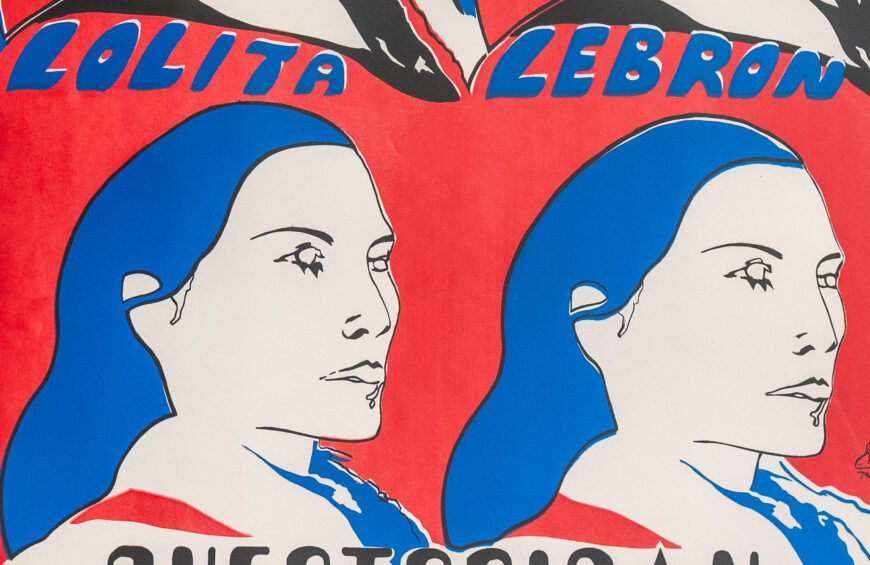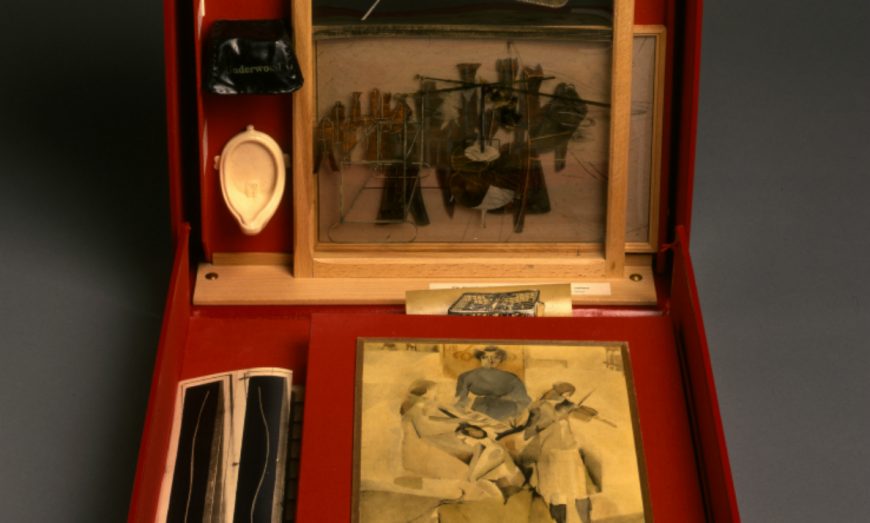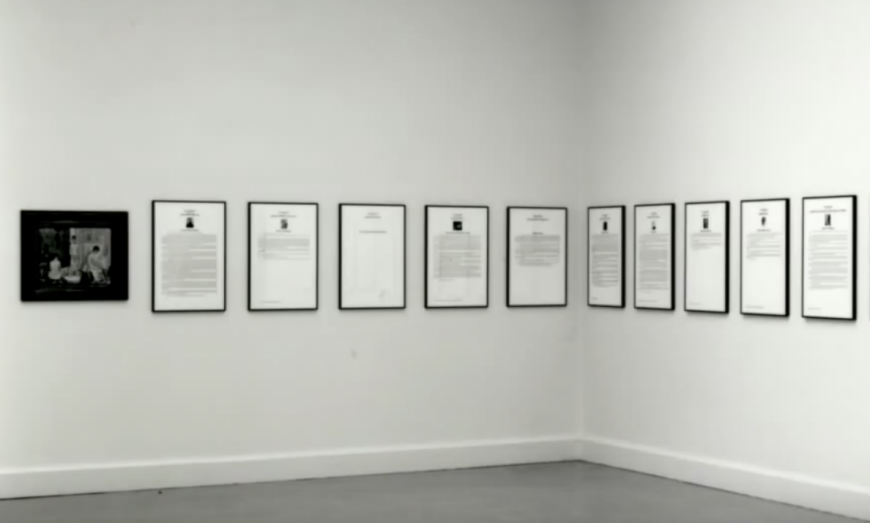Lyonel Feininger, Cathedral for Program of the State Bauhaus in Weimar, 1919, woodcut (Museum of Modern Art, New York)
[0:00] [music]
Dr. Steven Zucker: [0:03] This is Steven Zucker.
Dr. Juliana Kreinik: [0:04] And Juliana Kreinik. We are discussing Lyonel Feininger’s “Cathedral of the Future,” from 1919.
Dr. Zucker: [0:11] This was one of the primary images of the Bauhaus, right?
Dr. Kreinik: [0:14] It was the starting image.
Dr. Zucker: [0:15] Was its intent actually marketing? It was a brochure.
Dr. Kreinik: [0:19] This was a graphic work that was intended to be in poster format as announcement for the opening of the school, of this new Bauhaus.
Dr. Zucker: [0:29] It’s fabulous. Now, first, it’s a woodcut, and it’s rendered in a way that makes it feel very rough, not polished.
Dr. Kreinik: [0:36] I always think of it as a very stark, graphic work in its most raw sense, because of all the lines, and black and white, and there’s a bit of texture that you can almost see the impression from the wood. But then you also see all these angular sharp lines that come out. You see something emerging from within that. This is the cathedral of the future.
Dr. Zucker: [0:58] It’s so not what we think of when we think of the Bauhaus. When I think of the Bauhaus, I think of it as something that’s completely concerned with the technology of the present. Right?
Dr. Kreinik: [1:07] Yes.
Dr. Zucker: [1:08] Concerned with, to some extent, craft, not concerned with the religious. But in fact, early on, the Bauhaus was actually concerned, maybe not with the religious, but with the spiritual.
Dr. Kreinik: [1:18] Definitely the spiritual. This definitely has a sense that you’re looking at something otherworldly. Don’t forget, of course, this is a German school, so the sense of the spiritual and the cathedral, they’re all kind of connected, and art-making is part of that.
Dr. Zucker: [1:33] This is 1919. Germany is going through tremendous transition at this moment, right?
Dr. Kreinik: [1:37] Yes.
Dr. Zucker: [1:38] Is this just at the moment of the revolution in Germany? What’s happening?
Dr. Kreinik: [1:43] Everything is happening in terms of post-war chaos and re-formation. Rebuilding culture, rebuilding buildings, rebuilding a sense of purpose.
Dr. Zucker: [1:54] It’s interesting how the Bauhaus then becomes this fulcrum for the way in which the spiritual transforms itself into the technological or into the industrial.
Dr. Kreinik: [2:03] Yes. Technology, and spirituality, and redemption, all those themes come into play after World War I. There’s such a sense of decimation and hopelessness, but here, we have this image where there’s sort of a sense of optimism. Something that you’re looking up at and looking forward to.
[2:20] We could really talk about what the cathedral represents to the Bauhaus, and really, what is it about building. What does the word Bauhaus even mean?
Dr. Zucker: [2:28] Well Bauhaus refers to the small building or workshop that would be just outside of a large medieval building campaign, perhaps for a cathedral, in fact. You have the shop where the masons are doing their work outside.
[2:46] It is a place, as it was originally understood by Gropius, the artists would come together where there would be a unity of arts so that all of the crafts were, in a sense, working in unison to the betterment of that culture, the betterment of that society.
Dr. Kreinik: [3:02] We should talk about who Gropius was.
Dr. Zucker: [3:05] OK. Gropius was an architect and was the first director, really the founder of the Bauhaus.
Dr. Kreinik: [3:10] Right. And so that’s why we see that architecture is featured so prominently.
Dr. Zucker: [3:15] If you look at his diagram of the curriculum of the Bauhaus, architecture is in the center and it is positioned as the summation of all of the arts.
Dr. Kreinik: [3:24] Because it’s perceived in having elements of all of art-making. You have design. You have craftsmanship, color. You have form. You have space, all these different dimensionalities, everything that’s featured within architecture.
Dr. Zucker: [3:35] This may answer a question for me, because one of the things that I was thinking about when I was looking at this print is, why would Feininger choose a woodcut if it seems so historical? Really what we’re talking about is a return to a unity of the arts. The Bauhaus is looking towards a promise and looking forward. It is also very much trying to retrieve a kind of lost ideal.
Dr. Kreinik: [3:56] The graphic piece, it’s a woodcut. You’re working with your hands to carve out the design. Then, it’s a cathedral coming into view.
Dr. Zucker: [4:04] There’s a directness because of the quality of the woodcut that is very immediate. We can really feel, in a sense, the tactile nature of the block from which it was carved.
Dr. Kreinik: [4:14] What’s also so smart, if you think about technology, is, what reproduces well? A woodcut. It’s meant for reproduction. This is looking forward to technological reproduction, where they’re looking to advertise. It’s a marketing device. What’s going to work best in order to show everybody what their new school is about and what kind of ideology they’re trying to promote?
Dr. Zucker: [4:33] It’s interesting. That notion of the technological, of promise, and the sense of exploration is also referred to in the crystalline quality.
Dr. Kreinik: [4:42] Yes.
Dr. Zucker: [4:42] If you look at the kind of Expressionist architecture that’s being produced at this time in Germany, when there was an economic crisis and very little money, much of it was paper architecture, that is to say, really fanciful designs, but very often looking to this notion of the crystal light, the future as expressed through a series of sort of the drama and play of contrasting light and shadow.
[5:09] We see that clearly rendered here.
Dr. Kreinik: [5:11] These themes resonate throughout the time period of the Bauhaus, which was 1919 to 1933. At this point, Gropius starts the school.
Dr. Zucker: [5:21] Then it’s remade, of course. Gropius will truly remake it when he gets to Dessau and is able to design the buildings in which it’s housed.
Dr. Kreinik: [5:31] Then the coursework will grow and expand and will have all kinds of changes. But this really is the primary or original piece?
Dr. Zucker: [5:39] Yeah. In a sense, it’s this founding document.
Dr. Kreinik: [5:42] Founding document, that’s the word. Foundational document, even, is what this is probably best considered as.
Dr. Zucker: [5:48] By the time we get to the end of the Bauhaus’s run in the early 1930s, the spiritual was, to some extent, excised.
Dr. Kreinik: [5:54] Well, the idea of the spiritual transitions into something else, into notions of spiritual technology and its connections.
Dr. Zucker: [5:59] Oh, interesting.
Dr. Kreinik: [6:02] I think that the idea of what one is connected with spiritually changes.
Dr. Zucker: [6:07] Terrific. Thanks.
Dr. Kreinik: [6:08] Thank you.





